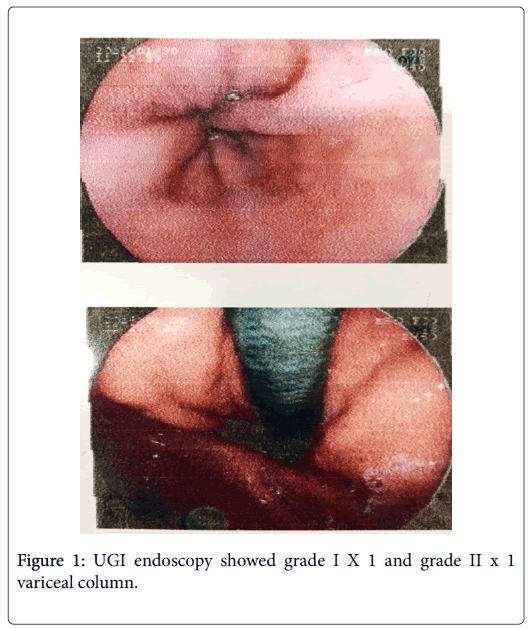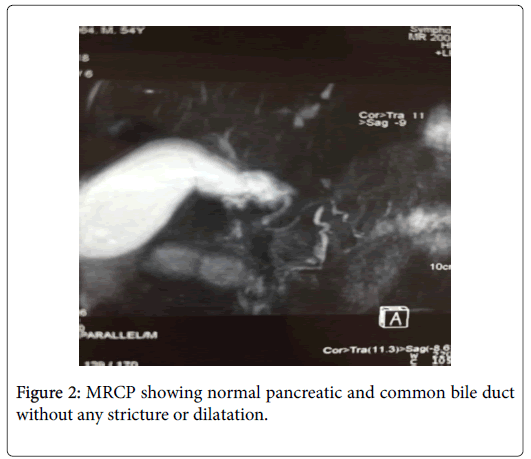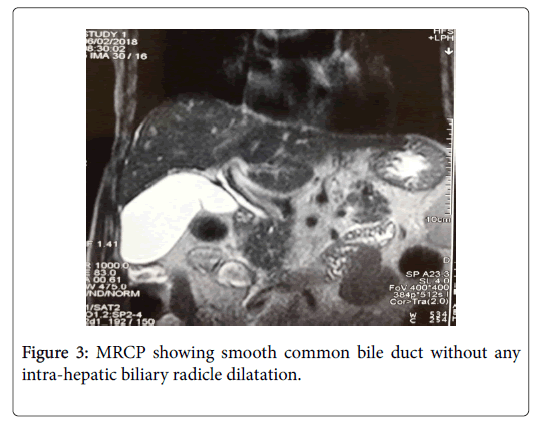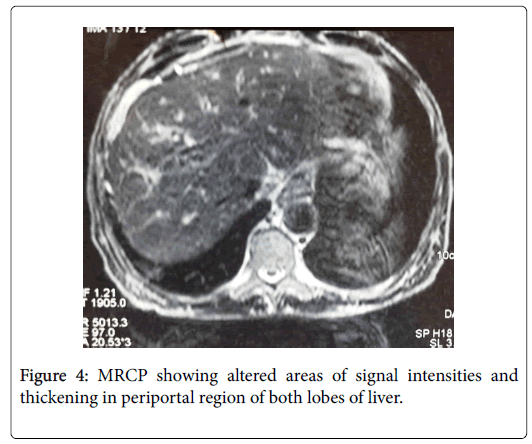Primary Biliary Cholangitis in a Male: A Rare Case
Received: 29-Sep-2018 / Accepted Date: 05-Nov-2018 / Published Date: 15-Nov-2018 DOI: 10.4172/2161-069X.1000579
Introduction
A 56 year old, male patient was admitted to a tertiary care hospital with the complaints of generalized itching and progressive jaundice of 6 months duration. There was no history of hemetemesis, malena or ascites. There was no history of fever preceding the onset of symptoms and he denied any history of drug intake in the preceding six months. There was no past history of jaundice, abdominal swelling. There was no history of alcohol intake and diabetes mellitus or any history of liver illness in the family.
His physical examination revealed stable vitals. General examination revealed icterus. His nails were shiny and had grade 1 clubbing. There were no spider naevi, parotidomegaly, palmer erythema. Per abdomen revealed a non tender abdomen with a palpable firm spleen of 3 cm and there was no other mass palpable. There was no free fluid on percussion. Examination of cardiovascular, respiratory and neurological system was unremarkable.
Investigations
Hemoglobin-10.1 mg/dL, normocytic normochromic picture, Total leukocyte count-5600/cm, Neutrophils 60%, Lymphocytes 24%, Eosinophil 3%, Basophils Nil and Monocytes 13%, Platelets-1.35 lakh/cm. Serum bilirubin-12.2 mg/dL; Direct/Indirect 8.2/4.0 mg/dL; Alkaline Phosphatase (ALP)-1280 IU/L (normal <130 IU/L); alanine aminotransferase-46 IU/L (normal<40 IU/L), aspartate aminotransferase-42 IU/L (normal <40 IU/L); Gamma-glutamyl Transpeptidase (GGT ) 554 (<125 IU/L); Serum albumin-3.1 g/dL; serum globulins-4.2 g/dL; Blood urea-34 mg/dL; Serum Creatinine-1.0 mg/dL; International normalized ratio-1.34. His Hepatitis B, Hepatitis C and Human Immunodeficiency Virus (HIV) serology was negative. His Anti-nuclear Antibodies (ANA), Smooth Muscle Antigen (SMA) was negative on immunofluorescence and by blot. His serum antimitochondrial antibody was positive with a titer of 1:68. Serum Antineutrophilic Cytoplasmic Antibody (ANCA) was negative.
Ultrasonography of abdomen showed splenomegaly of 16.2 cm, liver span was 9 cm with increased echotexture and portal vein was 12.8 mm at porta. Upper Gastrointestinal (UGI) endoscopy showed grade I X 1 and grade II X 1 variceal columns (Figure 1). Colonoscopy was normal. Magnetic Resonance Cholangio-pancreatography (MRCP) showed surface nodularity of liver with normal common bile duct and intra hepatic biliary radicles (Figures 2, 3 and 4).
Based on laboratory, immunological and imaging criteria the patient was diagnosed as case of primary biliary cholangitis. He was started on tablet Ursodeoxycholic Acid (UDCA) 300 mg three times a day and after 30 days of treatment his serum alkaline phosphatase has come down to 312 IU>3x reduction with improvement in pruritus and appetite.
Discussion
Primary Biliary Cholangitis (PBC) is an autoimmune liver disease characterized by biliary destruction, progressive cholestasis and potentially liver cirrhosis [1,2]. As the disease is increasingly diagnosed through the combination of cholestatic serum liver tests and the presence of antimitochondrial antibodies, most presenting patients are not cirrhotic and the term cholangitis is more accurate [3]. This disease predominatelty seen in females with a ratio of 9:1 to 12:1 in various studies [4,5]. Disease is characterisd by progressive jaundice, fatigue and pruritis [1]. Although the etiology of PBC has not yet been elucidated, Human Leukocyte Antigen (HLA) class II alleles have been consistently associated with disease onset for decades. PBC patients may also have genetically determined risk factors in non-HLA regions. Meanwhile, exposure to environmental factors, such as infectious diseases and harmful chemicals, can produce epigenetic alterations in some individuals and subsequent PBC onset a diagnostic criterion consists. PBC is diagnosed provided two of the following three criteria are satisfied:
• AMA titer>1:40;
• Alkaline Phosphatase (AP)>1.5 times the upper limit of normal for>24 week; and
• Compatible liver histology, demonstrating non suppurative destructive cholangitis and interlobular bile duct destruction [6].
The utility of histological assessment in PBC has been widely debated. We believe that obtaining a liver biopsy specimen provides an important tool to determine the stage of the disease, both at presentation and during follow-up. As compatible histology is one of the three internationally accepted diagnostic criteria, it should be pursued in those in whom the diagnosis is suspected but AMAs are negative and alkaline phosphatase levels normal [1,3]. UDCA in the dose of 12-15 mg/kg is the first line therapy. In patients with an inadequate response to UDCA (or UDCA intolerance) as defined by ALP>1.67 x ULN and/or elevated bilirubin<2X ULN, the addition of OCA (initial dose 5 mg/day, titrating to 10 mg/day at 6 months if tolerated) has been associated with improvements in biochemical surrogates of disease activity reasonably likely to predict improved outcomes [3].
Conclusion
Primary biliary disease is an uncommon cholestatic disorder especially in male patients. The purpose of this case report is to revisit the clinical presentation of a rare case and highlighting the importance of considering this diagnosis when liver function tests show a cholestatic picture.
References
- Lleo A, Marzorati S, Anaya JM, Gershwin ME (2017) Primary biliary cholangitis: A comprehensive overview. Hepatol Int 11: 485-499.
- Joshita S, Umemura T, Tanaka E, Ota M (2018) Genetics and epigenetics in the pathogenesis of primary biliary cholangitis. Clin J Gastroenterol 11: 11-18.
- Hirschfield GM, Dyson JK, Alexander GJM, Chapman MH, Collier J, et al. (2018) The British Society of Gastroenterology/UK-PBC primary biliary cholangitis treatment and management guidelines. Gut 67: 1568-1594.
- Kaplan MM (1996) Primary biliary cirrhosis. N Engl J Med 335: 1570-1580.
- Selmi C, Bowlus CL, Gershwin ME, Coppel RL (2011) Primary biliary cirrhosis. Lancet 377: 1600-9.
- Bowlus CL, Gershwin ME (2014) The diagnosis of primary biliary cirrhosis. Autoimmun Rev 13: 441-444.
Citation: Thakur R (2018) Primary Biliary Cholangitis in a Male: A Rare Case. J Gastrointest Dig Syst 8: 579. DOI: 10.4172/2161-069X.1000579
Copyright: © 2018 Thakur R. This is an open-access article distributed under the terms of the Creative Commons Attribution License, which permits unrestricted use, distribution, and reproduction in any medium, provided the original author and source are credited.
Share This Article
Recommended Journals
Open Access Journals
Article Tools
Article Usage
- Total views: 2861
- [From(publication date): 0-2018 - Mar 14, 2025]
- Breakdown by view type
- HTML page views: 2195
- PDF downloads: 666




